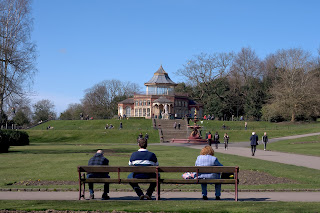Whilst shooting film for the last few years has been more fun than I imagined, I still enjoy using my DSLR's, particularly my Nikon D700. However I still have a soft spot for my first DSLR, my Nikon D90. I purchased my D90 in late July 2017 and for the first few months I used my Tamron Adaptall lenses on it until I could save enough cash for an autofocus lens. This gave me a good grounding in digital photography and made me learn to use manual mode straight from the start. Since moving up to full frame with my D700, my D90 has taken a back seat so I decided to take it out for an afternoon and put my manual focus 50mm f/1.8 AIS on it.
I was heading out to the park with my Nikon F801 and a roll of HP5 for a previous blog post. I saw it as an ideal opportunity to get reacquainted with my D90 and use it as a helpful way of finding my shots without wasting half a roll of film. I enjoy the synergy between Digital and Film photography that has helped me improve as a photographer. I know some folks will only shoot one or the other, but I find using both works for me.
The Nikon D90 has and APS-C sized sensor that Nikon describes as DX and has a decent line up of lenses it shares with the Nikon D3000, D5000 D7000 and D500 series of DX camera's. I only have 2 DX lenses, an AF-S Nikkor 18-55mm f/3.5-5.6 VR GII and a Tamron LD Di II 55-200mm f/4-5.6 macro. For travelling light this is all I will ever need, but lets not foget that all important F mount which means I can use just about every F mount lens Nikon has produced. having a drive motor in the camera body means I have more lenses to choose from than it's siblings that rely upon lenses with a motor built in to them.
There is the crop factor to take into consideration that effectively makes the 50mm lens I used a 75mm lens by multiplying the focal length, 50mm by the crop factor of 1.5, making my 50mm AIS a great portrait lens. This doesn't actually change anything about the lens, it changes the field of view to make it appear to be a longer focal length. It's a nice little optical advantage of using full frame and 35mm film camera lenses on an APS-C camera. The D90 also has a focus peaking indicator light in the viewfinder that lights up when focus is achieved in the centre of the lens. This is great for folks like myself who haven't the best eyesight and wear spectacles or contact lenses. If your eyes aren't too bad it has a diopter adjustment wheel that you can dial in to suit your eyesight without glasses or contacts.
I took a lot of photographs with my D90, but only chose seven to edit and put in an album on Flickr simply because most were similar compositions from slightly different angles and settings. Mike Browne's teaching skills got me doing that and it's a good habit to have. It also helped me get my film shots dialed in too. I am always amazed by this camera's dynamic range, but it's in good company as it shares the same sensor as the "Pro" level D300 DX camera. This ensures bright colourful images and a decent low light capability for those dull days or indoor events where a flash is not necessarily the best idea. This camera was aimed at the serious enthusiast and it has every right to be thought of as much more than an entry level DSLR. When covid allows us to get out and about again it will be coming with me a lot more and not just to back up my D700 and F801. The D90 is worthy of being described as a great travel camera on merit.
I really enjoyed using my D90 again, it's a breath of fresh air and keeps my skills up to speed. You can get a little too comfortable using the same camera all the time, even when it is a legend amongst DSLR's. My D90 keeeps me honest. Here are the 7 shots I chose from that session and you can also view them in full resolution on Flickr. I hope you enjoy them.








.jpg)


No comments:
Post a Comment